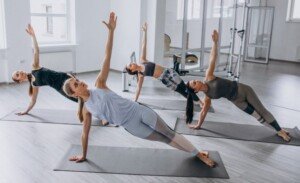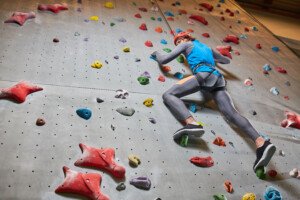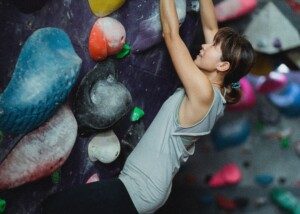Between rock wall climbing and yoga, which burns more fat depends on the skill level of the person.
There are circumstances under which climbing a wall with “holds” will burn far more calories or fat per the same time spent practicing yoga.
Let’s take a woman who’s a novice at indoor sport climbing and also yoga. She will struggle at both.
I used to spend a lot of time rock wall climbing and became a solid intermediate climber (5.10 level, which now equates to 3-4 and 4-5).
The one thing that any experienced climber will tell you is that very typically, novice men (and many beginning women) will try to “pull themselves up” the route.
Their torso or trunk will be squarely facing the wall as they struggle to pull themselves up using arm muscle.
This is more common in men because they have more upper body strength naturally, but stronger women who are new to climbing won’t be able to resist trying to pull themselves up the route.
This leads to quick fatigue. It’s essentially a weightlifting set.
It’s almost like trying to do ascending pull-ups with a little help from the legs and feet.
Yes, you can think of this as a strength training set in a vertical direction.
When the climb is done, especially if there’s a down-climb, the person will feel as worked over as they would after completing an intense set of deadlifts or, of course, chin-ups.
Imagine the calorie burn here. It’s several minutes of trying to pull one’s body weight upward with flailing legs.
Though it’s not all of their body weight, it’s a good chunk of it, because beginners don’t know how to ascend by pushing off with their legs and feet.
Instead they pull upward with their upper body. Even intermediate level climbers will find themselves struggling against their body weight and gravity, experiencing a lot of fatigue once they get off the route.
However, yoga for the beginner can induce quite a bit of feeling worked out.
When I was a personal trainer at a gym some years ago, I’d tell my clients, “Struggling burns fat.”
A novice who passionately tries to perform yoga poses will struggle and feel a workout with an elevated heart rate.

Freepik.com senivpetro
If they stick with yoga, several months later the poses that were difficult will be a breeze and feel like a simple warmup rather than an actual workout.
It’s the same with rock wall climbing. The person who struggles up a very beginner’s route will be expending a lot less energy ascending it several months later.
Which Burns More Fat, Indoor Climbing or Yoga?
The novice climber will burn more calories than the experienced yoga practitioner simply because he will be struggling and the latter won’t be.

Freepik.com/pressfoto
If that prolific yoga enthusiast is easily flowing through poses that seem impossible to most athletes, they are not in struggling (or high calorie burning) mode.
They are so well-adapted and trained that they’re barely breaking a sweat, if at all, and can comfortably converse while moving from one very impressive pose to the next.
You won’t be burning too many calories doing something that your body “thinks” is easy and that doesn’t elevate your heart rate much.
But if an inexperienced individual (who may be quite good at yoga) takes to climbing for the first time – that person will instinctively ascend the wrong way.
That means a lot of upper body pulling and yanking, simulating a set of vertical partial-bodyweight pull-ups.
This is a significant calorie burn for those several minutes.
Now if you take that, minute for minute, and compare it to a yoga class – the haphazard climbing wins hands-down for burning fat.
The novice wall climber will burn more calories, minute for minute, than will the novice yoga practitioner.
What About the Fat Burned by an Advanced Climber?
If you’ve ever watched skilled indoor climbers, they just don’t appear to be pulling themselves upward.

Even an intermediate level climber on a beginner’s route will not appear to be pulling themselves up – because they won’t be.
An experienced climber knows how to position their feet under themselves so that they can push upward with their legs, eliminating pull-up-like motions.
And along the way with all of their training, they’ve developed very strong fingers and forearms.
If they need to pause while in mid-climb without belayer support, they know how to position their feet and hands so that they are hanging straight-armed to conserve energy.
What about an advanced climber on a route that, to this individual, is difficult?
Well, because a skilled climber knows all the techniques of ascending and already has ridiculously strong fingers, wrists and forearms, those techniques will be applied even when the route challenges their skills.
Yoga involves no pulling upward of partial body weight or no gripping onto anything, though at the same time, advanced poses seem as far away as the moon to beginners.
I’m not aware of any research pitting the fat burn of climbing to yoga, but if you want to burn serious calories in 30 minutes and have never climbed before, I recommend climbing.
If you’re an experienced climber, I have to believe that you’ll still burn more calories or fat minute for minute than will a proportionately skilled yogi.
Yoga, by the way, will enhance climbing skills — so do both!









































